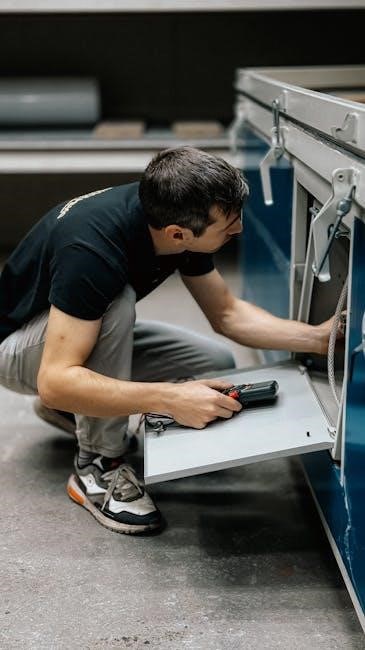A siphon pump is a device that uses gravity-driven flow to transfer liquids between containers or locations. It relies on creating a vacuum or pressure difference to initiate flow, making it a simple yet effective tool for various applications. Siphon pumps are commonly used in pools, aquariums, and fuel transfer scenarios. They are available in both manual and mechanical forms, offering versatility for different needs. Understanding how to use and maintain a siphon pump can enhance efficiency in liquid transfer tasks while ensuring safety and preventing contamination.
1.1 What is a Syphon Pump?
A siphon pump is a device that facilitates the transfer of liquids using gravity-induced flow. It relies on creating a pressure difference to initiate flow, often through manual or mechanical means. The pump typically consists of a hose, one-way valves, and a mechanism to start the siphon effect. Once activated, it can transfer liquids from a higher elevation to a lower one without external power. Manual siphon pumps are popular for their portability and simplicity, making them ideal for small-scale applications like draining pools or transferring fuel.
1.2 Importance of Syphon Pumps in Various Applications
Siphon pumps play a crucial role in efficiently transferring liquids in various settings, offering a cost-effective and environmentally friendly solution. They are essential for draining pools, aquariums, and fuel tanks, ensuring safe and contamination-free transfer. Manual siphon pumps are particularly valued for their portability and ease of use in remote or emergency situations. Their ability to function without electricity makes them ideal for marine applications and emergency water transfer scenarios. By preventing backflow and ensuring controlled flow, siphon pumps are indispensable tools for maintaining hygiene and efficiency in both domestic and industrial contexts.

Understanding the Mechanics of Syphon Pumps
Siphon pumps operate by creating a pressure difference, enabling liquid transfer through gravity-driven flow. They rely on manual or mechanical initiation to start the siphon effect, ensuring efficient liquid movement.
2.1 The Principle of Gravity-Driven Flow
The principle of gravity-driven flow is fundamental to siphon pumps, where liquid moves from a higher elevation to a lower one due to gravitational force. This natural process occurs when a pressure difference is created, typically by priming the system. The flow rate depends on factors like the height difference, pipe diameter, and fluid viscosity. In manual siphon pumps, this principle is harnessed to transfer liquids without external power, relying solely on gravity and the initial suction created by the user. Proper elevation alignment ensures smooth, efficient operation, making it a reliable method for various applications.
2.2 Role of One-Way Valves in Siphoning
One-way valves are essential in siphon pumps as they ensure fluid flows in a single direction, preventing backflow. These valves open under pressure during suction, allowing liquid to enter, and close automatically when pressure drops, stopping reverse flow. This mechanism maintains the siphon effect, preventing the system from collapsing. In manual siphon pumps, one-way valves are typically placed at the intake and discharge points. They are often made of durable materials like silicone or PVC, ensuring reliability and resistance to contamination. Properly functioning one-way valves are critical for efficient and continuous operation of manual siphon pumps.
2.3 How to Create a Siphon Effect Manually
Creating a siphon effect manually involves submerging the hose into the liquid source and generating suction. Start by placing the intake end of the hose into the liquid, ensuring it is fully submerged. Use your mouth or a manual pump to create suction at the other end until liquid begins to flow. Once the siphon is initiated, the flow will continue due to gravity. To maintain the effect, ensure the outlet remains lower than the liquid source. If the flow stops, repeat the suction process or pinch the hose to trap water and restart the flow.
Types of Syphon Pumps
Manual syphon pumps are simple, portable tools for transferring liquids, while mechanical pumps offer higher efficiency. Specialized pumps cater to pools, fuel, and marine applications.
3.1 Manual vs. Mechanical Syphon Pumps
Manual syphon pumps rely on gravity and manual suction to initiate flow, making them simple and portable. They are ideal for small-scale applications like draining pools or aquariums. Mechanical syphon pumps, however, use a motorized mechanism to create suction, offering faster and more efficient liquid transfer. These are better suited for heavy-duty tasks or continuous use. Manual pumps are cost-effective and require no power, while mechanical pumps provide higher flow rates and convenience. The choice depends on the specific needs, such as volume, portability, and available resources.
3.2 Pool and Aquarium Syphon Pumps
Pool and aquarium syphon pumps are essential for maintaining water quality by draining or transferring liquids. Manual models are popular for small-scale use, relying on gravity and suction to create flow. These pumps are lightweight and portable, making them ideal for cleaning aquariums or emptying pool covers. They often feature durable hoses and easy-to-use designs. Regular maintenance, such as cleaning the hose and ensuring proper venting, is crucial for optimal performance. These pumps are cost-effective and environmentally friendly, offering a reliable solution for aquatic applications without the need for electricity.
3.3 Fuel Transfer Syphon Pumps
Fuel transfer syphon pumps are designed for safely moving flammable liquids like gasoline or diesel. Manual models are popular for their simplicity and reliability, often featuring rugged construction to withstand harsh environments. These pumps typically include anti-static hoses and secure fittings to prevent leaks and sparks. They are widely used in automotive, marine, and industrial settings for draining tanks or transferring fuel between containers. Their portability and ease of use make them ideal for emergency situations or remote locations where electricity isn’t available. Regular maintenance ensures safe and efficient operation.
3.4 Marine and Boat Syphon Pumps
Marine and boat syphon pumps are specialized for use in aquatic environments, often designed to transfer water or other liquids on vessels. Manual models are favored for their reliability without electricity, making them ideal for bilge pumping or deck washing. Durable materials like stainless steel or PVC ensure resistance to corrosion and seawater damage. These pumps are compact, lightweight, and portable, fitting easily in tight marine spaces. Safety features include anti-siphon valves to prevent backflow and contamination. Their versatility makes them essential for maintenance, emergencies, or routine tasks on boats, ensuring smooth operation in challenging marine conditions.

Key Components of a Syphon Pump
A syphon pump’s key components include a durable hose, an efficient pump mechanism, reliable one-way valves, and secure fittings, ensuring smooth siphoning and preventing backflow for long-lasting performance.
4.1 The Hose and Its Material
The hose is a critical component of a syphon pump, typically made from durable materials like rubber, PVC, or silicone. These materials ensure flexibility, chemical resistance, and longevity. The inner diameter of the hose determines flow rate, with larger diameters allowing higher volumes. For manual syphon pumps, hoses are often lightweight and kink-resistant to maintain consistent flow; The material must also withstand the liquid being transferred, whether water, fuel, or chemicals. Proper hose construction ensures reliable performance and prevents leaks or damage during operation, making it essential for effective siphoning in various applications.
4.2 The Pump Mechanism
The pump mechanism in manual syphon pumps is designed to create suction and initiate the siphon effect. Typically, it involves a manual operation, such as squeezing a bulb or operating a lever, to generate negative pressure. This action draws liquid through the inlet and into the hose. One-way valves ensure that liquid flows in one direction, maintaining the siphon once it is established. Unlike mechanical pumps, manual syphon pumps rely on user effort to prime the system. Their simple design makes them lightweight and easy to use, with minimal moving parts, ensuring reliability and efficiency in transferring liquids over short distances.
4.3 Valves and Seals
Valves and seals are critical components in manual syphon pumps, ensuring efficient and leak-free operation. One-way valves, often located at the inlet and outlet, prevent backflow and maintain the siphon effect once it is initiated. These valves are typically made of durable materials like rubber or PVC to withstand frequent use. Seals, such as gaskets or O-rings, are essential for creating airtight connections between components, preventing liquid leakage. Properly functioning valves and seals are vital for maintaining the pump’s performance and ensuring safe, reliable operation across various applications.
4.4 Fittings and Connectors
Fittings and connectors are essential for securing the hose to the pump and ensuring a leak-free connection. Common types include threaded fittings, push-fit connectors, and barbed fittings, each designed for specific applications. High-quality materials like PVC, brass, or stainless steel are used for durability and resistance to corrosion. Properly sealing these connections is critical to prevent leaks and maintain the integrity of the siphon effect. Adapters and couplers may also be used to accommodate different hose sizes or setups, ensuring versatility and compatibility across various systems. Regular inspection of these components is vital for reliable operation.

Safety Considerations
Ensure safe handling of hazardous liquids, prevent backflow, and maintain proper ventilation. Always follow manufacturer guidelines to avoid accidents and contamination risks during siphoning operations.
5.1 Preventing Backflow and Contamination
Preventing backflow and contamination is crucial when using syphon pumps. Install one-way valves to ensure liquids flow in a single direction, reducing the risk of reverse flow. Regularly inspect and maintain the pump to avoid leaks or blockages that could lead to contamination. Use food-grade hoses and fittings to prevent chemical leaching. Store the pump in a clean, dry environment after use. Always test the pump with clean water before transferring liquids to ensure no residual contamination. Proper priming and venting techniques also help maintain a sterile siphoning process, safeguarding both the pump and the liquid being transferred.
5.2 Handling Hazardous Liquids Safely
When using syphon pumps for hazardous liquids, prioritize safety to minimize risks. Always wear protective gear, including gloves, goggles, and a mask. Ensure the pump and hose are made from materials compatible with the liquid to prevent chemical reactions. Use proper ventilation in enclosed spaces to avoid inhaling fumes. Follow all safety guidelines for the specific liquid being transferred. Store hazardous liquids in approved containers and dispose of them according to regulations. Regularly inspect the pump for damage to prevent leaks. Keep emergency equipment nearby, such as spill kits and fire extinguishers, to handle accidental spills or leaks effectively.
5.3 Proper Venting Techniques
Proper venting is crucial for efficient and safe operation of syphon pumps. Ensure the system allows air to enter and exit freely to prevent pressure buildup. Check for blockages in vents or hoses, as restricted airflow can disrupt the siphon effect. Use appropriately sized vents to maintain optimal flow rates. Regularly inspect vent openings for debris or damage. In enclosed systems, ensure adequate ventilation to avoid gas accumulation. Proper venting not only enhances performance but also prevents potential hazards like backflow or overflow. Follow manufacturer guidelines for venting specific to your syphon pump model.

Choosing the Right Syphon Pump
Selecting the right syphon pump involves assessing flow rate needs, liquid type, and portability. Consider manual or mechanical options based on application and ease of use requirements.
6.1 Assessing Flow Rate and Head Pressure Needs
When selecting a manual syphon pump, it’s crucial to evaluate the required flow rate and head pressure. The flow rate determines how quickly liquids can be transferred, while head pressure indicates the height the pump can lift the liquid. Consider the volume of liquid and the vertical distance it needs to be moved. For manual pumps, lower flow rates and head pressures are typical, but they still need to meet the specific demands of the task. Ensure the pump’s capacity aligns with the application to maintain efficiency and effectiveness. Proper assessment prevents underperformance or overexertion during use.
6.2 Material Compatibility with Liquids
Material compatibility is vital when choosing a manual syphon pump. The pump’s components, such as hoses and valves, must withstand the liquid being transferred. For example, PVC and silicone materials are ideal for water and chemicals, while stainless steel is better for corrosive substances. Incompatible materials can degrade, leading to contamination or pump failure. Always check the manufacturer’s compatibility chart to ensure the pump is suitable for the liquid type. This step ensures safe, efficient, and long-term operation of the syphon pump in various applications.
6.3 Portability and Ease of Use
Portability and ease of use are crucial for manual syphon pumps, especially in outdoor or emergency settings. Lightweight designs and compact constructions make these pumps easy to carry and transport. Many models feature ergonomic handles or lever-style mechanisms that simplify operation. Easy-to-use designs minimize the effort required to prime the siphon effect, ensuring quick setup and operation. This portability makes manual syphon pumps ideal for applications like camping, pool maintenance, or emergency water transfer. Their user-friendly nature ensures efficiency and reduces fatigue during extended use.

Step-by-Step Installation Guide
This section provides a detailed, easy-to-follow guide for installing manual syphon pumps. It covers preparation, priming, and securing connections to ensure smooth operation.
- Prepare the pump and hose according to manufacturer instructions.
- Prime the syphon effect to initiate fluid flow.
- Secure all connections and test the system thoroughly.
7.1 Preparing the Pump and Hose
Before installing a manual syphon pump, ensure all components are included and undamaged. Inspect the hose for kinks or blockages and attach it securely to the pump. Submerge the hose in water to check for leaks. Position the pump at the lowest point of the system to maximize siphoning efficiency. Align the inlet and outlet ports correctly, ensuring they face the desired directions. Tighten all connections firmly to prevent air leaks, which could disrupt the siphon effect. Proper preparation ensures smooth operation and minimizes the risk of issues during use.
7.2 Priming the Syphon Effect
To initiate the siphon effect, submerge the hose into the liquid source, ensuring the inlet is fully covered. For manual pumps, squeeze the bulb or activate the lever to create suction. This removes air from the hose, allowing liquid to flow. Continue priming until water flows steadily without air bubbles. Proper priming is essential for maintaining the siphon effect. If air enters the system, the flow may stop, requiring re-priming. Once primed correctly, the pump will sustain the flow, enabling efficient liquid transfer.
7.3 Securing Connections and Testing
After priming, secure all connections to ensure a tight seal. Tighten hose fittings and connectors firmly to prevent leaks. Once secured, test the pump by activating it to check for proper flow and functionality. Verify that liquid flows smoothly and consistently. Inspect for any leaks at connections or seals. If issues arise, tighten fittings or replace worn seals. Testing ensures the pump operates efficiently and safely, confirming readiness for use. Properly secured connections and successful testing are critical for reliable performance and longevity of the syphon pump;

Maintenance and Troubleshooting
Regular cleaning and inspection ensure optimal performance. Check for wear, damage, or blockages. Replace faulty seals or valves promptly. Troubleshoot issues like poor flow or leaks.
8.1 Cleaning and Storing the Pump
Clean the syphon pump regularly to remove debris and residues. Disassemble the pump and soak parts in mild detergent. Rinse thoroughly and dry before reassembly. Store in a cool, dry place, away from direct sunlight. Ensure all hoses are drained and coiled neatly to prevent kinking. Apply a thin layer of lubricant to moving parts to prevent rust. Proper storage extends the pump’s lifespan and ensures readiness for future use. Always follow the manufacturer’s guidelines for cleaning and maintenance to avoid damage.
8.2 Diagnosing Common Issues
Identify issues by observing pump performance. Low suction or no flow may indicate blockages in the hose or mouthpiece. Check for kinks or debris and clear them. Air leaks in connections or worn valves can disrupt the siphon effect—inspect and tighten seals. If the pump fails to prime, ensure the hose is submerged and the pump is correctly aligned. For mechanical pumps, faulty check valves or worn impellers may require replacement. Regularly inspecting parts helps prevent malfunctions. Consult the manual for troubleshooting guides specific to your syphon pump model to address issues effectively and maintain optimal functionality.
8.3 Replacing Worn-Out Parts
Replace worn-out parts to maintain your syphon pump’s efficiency. Common replacements include hoses, gaskets, and valves. Start by turning off the pump and draining liquids. Disconnect the hose and disassemble the pump to access the faulty part. Use pliers or screwdrivers to remove and install the new component. Ensure all connections are tight to prevent leaks. Regularly replacing worn parts prevents breakdowns and extends the pump’s lifespan. Always refer to the manual for specific instructions and use manufacturer-recommended parts for compatibility and optimal performance.

Advanced Applications
Syphon pumps are used in irrigation, laboratories, and emergency water transfers, showcasing their versatility in complex tasks beyond basic fluid transfer, optimizing efficiency in specialized settings.
9.1 Using Syphon Pumps in Irrigation Systems
Manual syphon pumps are invaluable in irrigation systems, particularly in agriculture, where they enable efficient water transfer for crops. By leveraging gravity-driven flow, these pumps can water large fields or specific plants without electricity, making them ideal for remote or off-grid farming. Their portability and simplicity allow farmers to redistribute water from ponds or reservoirs to areas needing irrigation. This cost-effective solution minimizes reliance on fuel-powered equipment, reducing operational costs and environmental impact. Additionally, syphon pumps are durable and require minimal maintenance, making them a reliable choice for small-scale farming or community garden projects.
9.2 Syphon Pumps in Laboratory Settings
Manual syphon pumps are frequently utilized in laboratory settings for precise liquid transfer, such as chemicals or samples, without requiring electricity. Their simplicity and reliability make them ideal for controlled environments where avoiding contamination is critical. Labs often use syphon pumps to handle small volumes or sensitive materials, as they minimize exposure to hazardous substances. Additionally, their portability and quiet operation are advantageous in busy lab spaces. The absence of electrical components also reduces fire hazards, making them a safer choice for handling flammable or volatile liquids in research and testing scenarios.
9.3 Emergency Water Transfer Scenarios
Manual syphon pumps are invaluable in emergency water transfer scenarios, such as floods, natural disasters, or firefighting operations. Their portability and ability to function without electricity make them ideal for disaster relief. These pumps can quickly drain flooded areas or transfer water for drinking and sanitation. In remote locations, where power sources are unavailable, manual syphon pumps ensure reliable water management. Their simplicity and durability also make them a critical tool for first responders and emergency teams, enabling rapid and efficient water transfer to mitigate crisis situations effectively.

Environmental Considerations
Manual syphon pumps are eco-friendly, reducing energy consumption and minimizing environmental impact. They prevent contamination by safely transferring liquids, promoting sustainable water management and conservation practices effectively.
10.1 Energy Efficiency of Manual Pumps
Manual syphon pumps are highly energy-efficient as they operate without electricity, relying on manual effort. This eliminates the need for fossil fuels, significantly reducing carbon emissions and energy costs. Their simplicity ensures minimal mechanical complexity, reducing overall resource consumption. In remote or off-grid locations, manual pumps are ideal for water transfer, promoting sustainable water management. They also lower long-term maintenance costs due to fewer moving parts. By minimizing energy use, manual syphon pumps contribute to a greener, more environmentally friendly solution for liquid transfer needs in various applications.
10.2 Preventing Environmental Contamination
Manual syphon pumps play a crucial role in preventing environmental contamination by ensuring safe liquid transfer. Properly designed pumps with leak-proof seals and durable materials minimize the risk of spills. Regular maintenance, such as checking for worn-out parts and ensuring tight connections, further reduces contamination chances. Additionally, using food-grade hoses and non-toxic materials prevents harmful chemical leaching. Proper disposal of transferred liquids and cleaning the pump after use also safeguard ecosystems. By adhering to these practices, manual syphon pumps help maintain environmental integrity and reduce ecological risks associated with liquid transfer operations.
Manual syphon pumps offer efficient, versatile solutions for liquid transfer, ensuring reliability across various applications. Proper use and maintenance are key to their longevity and effectiveness.
11.1 Summary of Key Points
Manual syphon pumps are efficient tools for liquid transfer, relying on gravity and suction to initiate flow. They are versatile, used in pools, aquariums, and fuel transfer, offering reliability. Proper installation, including height differences and priming, is crucial for operation. Maintenance involves cleaning and replacing worn parts. Safety measures, like preventing backflow and using compatible materials, ensure longevity. Portability and ease of use make them ideal for various applications. Regular checks and storage prolong their lifespan. Understanding their mechanics and applications ensures effective use in both everyday and advanced scenarios, making them indispensable for fluid management needs.
11.2 Final Thoughts on Effective Siphon Pump Use
Effective use of manual syphon pumps requires understanding their mechanics and proper setup. Always ensure height differences and priming are correctly managed for consistent flow. Safety should never be overlooked, with measures like preventing backflow and using compatible materials. Regular maintenance, such as cleaning and part replacement, ensures longevity. By following guidelines and applying best practices, users can maximize efficiency and reliability. Manual syphon pumps remain a practical, eco-friendly solution for fluid transfer, offering both convenience and durability when used responsibly. Proper care and adherence to safety protocols ensure safe and effective operation in various applications.
